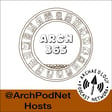Become a Creator today!Start creating today - Share your story with the world!
Start for free
00:00:00
00:00:01

Roskilde - Episode 18037
Roskilde a Danish city with a fascinating history in its own right and whose origins date back to the pre-christian Viking age is most well known for the Danish Viking Ship Museum.
Recommended
Transcript
Roskilde's Viking Origins and Museum
00:00:01
Speaker
You're listening to the Archaeology Podcast Network. Rose Kilday, a Danish city with a fascinating history in its own right, and whose origins date back to the pre-Christian Viking Age, is most well known for the Danish Viking Ship Museum. This is episode 37 for February 6, 2018. I'm Chris Webster, and welcome to the ARC 365 podcast, 2018 edition. ARC 365 is a podcast today, every day, in 2018.
00:00:32
Speaker
This network is supported by our listeners.
Supporting the Network
00:00:34
Speaker
You can become a supporting member by going to arcpodnet.com slash members and signing up. As a supporting member, you have access to high quality downloads of each show and a discount at our future online store and access to show hosts on a members only Slack team. For professional members, we'll have training shows and other special content offered throughout the year.
00:00:55
Speaker
Once again, go to arkpodnet.com slash members to support the network and get some great extras and swag in the process. That's arkpodnet.com slash members.
Viking History and Roskilde's Development
00:01:23
Speaker
No archaeological traces of these buildings have been found, but excavations in the 1990s did uncover the remains of several Viking ships in the Isfjord, which have been dated to the 11th century. At this date, approximately 50 years after the supposed foundation of the city, there were two churches in the area, St. Jorgenspjörg,
00:01:40
Speaker
an early stone church, and a wooden church discovered beneath the current St. Ives Church. The city seems to have originally developed on this site as a hub for both land and sea trade routes that were exploited by the Vikings from as early as the 6th century. It is thought that the name Rosekilde, meaning Rose Spring, was associated with the legendary King Rohr, who possibly lived in the area in the 6th century. From the 11th century until 1443, Rosekilde was the capital of Denmark. Coins were minted there from the 11th to 14th centuries
00:02:08
Speaker
By at least 1134, it had a market charter. In 1020, King Canute made it to the seat of the bishopric, giving it even more regional importance. The first Danish bishop of Roskilde, Absalon, built a brick church on the site of an earlier wooden church in 1170, and the present cathedral in the city was completed in 1275 under the sixth bishop. By the time of the Reformation in Denmark around 1536, there were 12 churches, a cathedral, and five monasteries in the city.
00:02:35
Speaker
The Reformation brought the development of the city to a stop, and whilst the cathedral remained the location of burial for Danish monarchs, most of the other religious establishments were dismantled. In the early modern period, the city suffered what has been described as three centuries of disaster, including the effects of the Danish-Swedish War, the plague, and a series of fires.
00:02:55
Speaker
The present city seems to have recovered in status somewhat and is now known for its exemplary Viking ship museum.
Viking Ship Museum's Role in Research
00:03:00
Speaker
The museum focuses on the five Viking ships, called the Skuldalev ships, which were excavated near the city in 1962. These ships were deliberately sunk in around 1070 at the entrance to Roskilde Fjord to protect the city from attack. These ships were each different types.
00:03:16
Speaker
ranging from cargo vessels to warships. In 1996 and 1997, an expansion of the museum's shipyard led to the recovery of nine further ships from the Viking Age and the early medieval period. These excavations from the largest single discovery of ships in northern Europe and one of the vessels, the Roskilde VI, is the longest Viking warship ever found at 36 meters.
00:03:37
Speaker
Although the original five vessels were the focus of the museum, there is a new exhibition about the most recently excavated ships and broader maritime archaeology in the region. The Viking Ship Museum is also a world leader in research and education relating to maritime history, marine archaeology, and experimental archaeology. This includes a series of over 40 reconstructed ships, mainly of Viking types, made with the tools and techniques that would have been used at that time.
00:04:01
Speaker
Each summer, these ships and boats are launched so that experimental archaeologists can learn more about the seafaring techniques of the Viking Age.
Podcast Information and Credits
00:04:07
Speaker
Thank you.
00:04:14
Speaker
Thanks for listening to ARC 365. If you want to hear more ARC 365, check out www.arcpodnet.com slash ARC365 for the 2017 and 2018 episodes. Check out arcpodnet.com slash ARC365-G30 for the last 30 episodes. Please subscribe and rate on your service of choice. We're available on iTunes, Stitcher, and Google Play, among others. Support the APN at arcpodnet.com slash members. Thanks for listening, and thanks for being awesome.
00:04:44
Speaker
This show is produced and recorded by the Archaeology Podcast Network, Chris Webster and Tristan Boyle, in Reno, Nevada at the Reno Collective. This has been a presentation of the Archaeology Podcast Network. Visit us on the web for show notes and other podcasts at www.archpodnet.com. Contact us at chrisatarchaeologypodcastnetwork.com.
